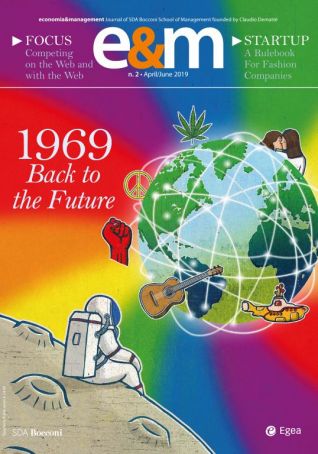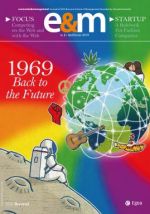E&M
2019/2
The Meeting/Clash Between Material and Imaginary
Download article as PDFOur readers may wonder why, on our 50th anniversary, our magazine has decided to dedicate so much attention to the year 1969. The answer, as we will attempt to illustrate in this dossier, is because some of the events from that year were very important for the issues we still deal with today; more so than the events of 1968, another symbolic year whose importance and legacy have recently been the subject of considerable reflection.
The movements of ’68 and the May protests in France were in fact evidence of a generational clash and a new awareness among youth.[1] As stressed by the sociologist Shmuel Eisenstadt, youth communities represent temporary institutions, and the age changes on which they are based can represent the foundation of a counterculture able to transform society. That impulse requires the affirmation of more stable collective identities. In 1969, we see some events that indicate a development of this type. They include, in chronological order: the Stonewall riots (June 28-29) that marked the beginning of the “modern” homosexual liberation movement; the landing of a man on the moon (July 20), the final outcome of a space race between the USSR and the United States of America, driven by the Cold War; the Woodstock festival (August 15-18), the “peace and music” gathering that marked the height of the hippie generation; the so-called “hot autumn”, the season of labor conflict that engulfed Italy starting in September; and the birth of the Internet, through the ARPANET network, that sent its first message between two connected computers on October 29.
These are events that, despite belonging to a specific time in history, deeply influenced some of the technological and social perspectives that characterize our present, and are reflected in many of the new sectors that define our current economic panorama. I would in fact start with technology, and the event that represents a symbol of its most advanced state: the landing of a man on the moon. Despite being a result that undoubtedly indicates the technological supremacy of one nation within a conflict such as that of the Cold War, it is a step forward – as Neil Armstrong stated when he first stepped onto the surface – for all of humanity. While the Manhattan Project, which was similar in terms of breadth and complexity of technological effort, had given us a weapon of mass destruction, the atomic bomb capable of destroying our world, the landing on the moon opened us up to new worlds, and to look not at the divisions that separate us on earth, but at what can unite us in moving towards new frontiers. It is this idea of collectivity and sharing that would be the basis for many future technological developments, such as the personal computer and a network able to connect them (like ARPANET, that then became the Internet).
Woodstock represents the exemplification of this common vision and sense of collective participation. If we look at the images of the documentary that was filmed of the three-day event,[2] that would bring approximately 400,000 people to a rural area to listen to a concert together, the first thing we note is in fact the collective perspective, as if the people were part of a single organism. They lived together, and they listened together to a collective good par excellence, live music. There was no private property. The body and nudity were visible; not hidden, but not shown off either. Sex was free and unconditioned by exclusive relationships. A lot of marijuana was smoked, but in this case as well, consumption was not individual, but shared with others in a collective rite.
It is in that context of “liberation”, and thus necessarily of conflict with respect to the dominant values and structures of the time, that the battle for the civil rights of homosexuals developed, along with worker and trade union struggles. 1968, with its university occupations and the May clashes in France, had in fact spread instruments of struggle, but with social aspirations (“we want everything, immediately!”) that would be picked up again in 1969 by groups that would recognize (or reaffirm) their collective identity in their sexual orientation or class condition. For the homosexual movement, this would mean first of all clash and rejection of existing models (gay is good), coming out not only individually but collectively, and symbolically occupying public places of the dominant society with gay pride marches. For the workers movement, this caused widespread conflict in the factories with innovative forms of struggle, new structures of worker representation, the gradual expansion of union rights in factories, new methods of bargaining, and innovative forms of contracts. Looking back after fifty years, we can see how the economic system reacted differently to these two different demands: integrating LGBT people since they are consumers, and dis-integrating workers through technology (or related outsourcing), since they are producers.
In October 1969, Life magazine[3] identified the fundamental elements of the counterculture as sex, drugs and rock n’roll, that would become a celebrated trio. In this dossier we stress how each of the three components, even those considered the most “scandalous” – i.e. sex and drugs – found growing social legitimation and increasingly intense legal commercial exploitation. While mainstream culture focused attention on these single components, considered to be “indecent”, but failed to take a broader view, the risk today, on the other hand, is silence in research on some of these sectors. Indeed, many entrepreneurial ideas can be traced to the counterculture, ideas that have seen broad success in contemporary society: from hacker movements, to free software, to the recent evolutions of the sharing economy. And that same culture is the context for the famous phrase “stay hungry, stay foolish” pronounced by Steve Jobs. Jobs had revived the motto of the famous counterculture magazine The Whole Earth Catalogue, that some consider the forebear of Google and whose cover was always dedicated to an image of the Earth seen from space and from the moon. The image is just how the Earth appeared to the Apollo 11 astronauts, whose success – unthinkable without a computerized piloting system – came a few months after the release of the Stanley Kubrick’s film 2001: A Space Odyssey. The film shows a conflict between man, technology and artificial intelligence, represented by the HAL computer, which is very evident and relevant today.
If 1968 was symbolically the year of imagining a new world, 1969 was the year in which the transformation began, sowing some of those seeds whose fruits we see today. 1969 can in fact be considered the year of the meeting between the material and the imaginary, and also the conflict that was generated by that meeting. It was the year that the merger between technology and society became evident, that would open new prospects to create the worlds dreamt of and imagined in the previous years, and maybe also some nightmares.
P. Ortoleva, I movimenti del '68 in Europa e in America, Rome, Editori Riuniti, 1998.
Woodstock (1970), by Michael Wadleigh. The film won the Oscar for best documentary.
E. Kern, “Can it happen here?”, Life, 17/10/1969, pp. 66-78.




